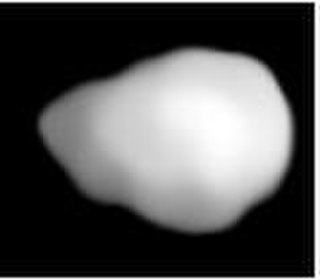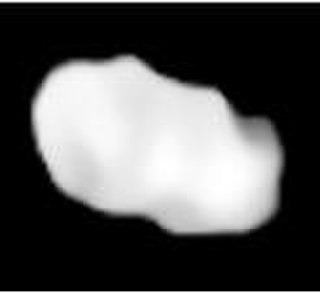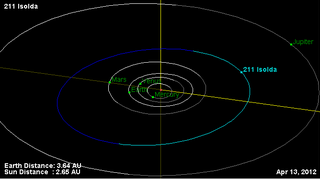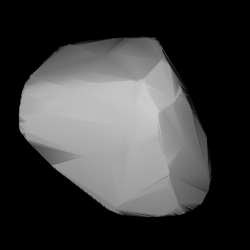
Antiope is a double asteroid in the outer asteroid belt. It was discovered on October 1, 1866, by Robert Luther. In 2000, it was found to consist of two almost-equally-sized bodies orbiting each other. At average diameters of about 88 km and 84 km, both components are among the 500 largest asteroids. Antiope is a member of the Themis family of asteroids that share similar orbital elements.

Leda is a large, dark main-belt asteroid that was discovered by French astronomer J. Chacornac on January 12, 1856, and named after Leda, the mother of Helen of Troy in Greek mythology. In the Tholen classification system, it is categorized as a carbonaceous C-type asteroid, while the Bus asteroid taxonomy system lists it as a Cgh asteroid. The spectra of the asteroid displays evidence of aqueous alteration.

Daphne is a large asteroid from the asteroid belt. It is a dark-surfaced body 174 km in diameter is probably composed of primitive carbonaceous chondrites. The spectra of the asteroid displays evidence of aqueous alteration. It was discovered by H. Goldschmidt on May 22, 1856, and named after Daphne, the nymph in Greek mythology who was turned into a laurel tree. Incorrect orbital calculations initially resulted in 56 Melete being mistaken for a second sighting of Daphne. Daphne was not sighted again until August 31, 1862.

Hekate is a large main-belt asteroid.

Hermione is a very large binary asteroid discovered in 1872. It orbits in the Cybele group in the far outer asteroid belt. As an asteroid of the dark C spectral type, it is probably composed of carbonaceous materials. In 2002, a small moon was found to be orbiting Hermione.

Elektra is a large outer main-belt asteroid and quadruple system with three minor-planet moons. It was discovered on 17 February 1873, by astronomer Christian Peters at Litchfield Observatory, New York, and named after Electra, an avenger in Greek mythology.

Ophelia is a large, dark Themistian asteroid that was discovered by French astronomer Alphonse Borrelly on 13 January 1877, and named after Ophelia in Shakespeare's Hamlet.

175 Andromache is a main-belt asteroid that was discovered by Canadian-American astronomer J. C. Watson on October 1, 1877, and named after Andromache, wife of Hector during the Trojan War. Watson's telegram to Europe announcing the discovery became lost, and so notification did not arrive until several weeks later. As a result, another minor planet, later designated 176 Iduna, was initially assigned the number 175.

Prokne is a main-belt asteroid that was discovered by German-American astronomer C. H. F. Peters on March 21, 1879, in Clinton, New York, and named after Procne, the sister of Philomela in Greek mythology. Stellar occultations by Prokne have been observed twice, in 1984 from Italy and again in 1999 from Iowa.

Isolda is a very large, dark main-belt asteroid. It is classified as a C-type asteroid and is probably composed of primitive carbonaceous material. The spectra of the asteroid displays evidence of aqueous alteration.

Polyxo is a main-belt asteroid that was discovered by A. Borrelly on March 31, 1891, in Marseilles. It is orbiting the Sun at a distance of 2.75 AU with a low orbital eccentricity (ovalness) of 0.04 and a period of 4.56 yr. The orbital plane is tilted at an angle of 4.36° to the plane of the ecliptic.

Huenna is a large asteroid orbiting in the asteroid belt. It is part of the Themis family, and thus a C-type asteroid and consequently composed mainly of carbonaceous material.
Gyptis, minor planet designation: 444 Gyptis, is a main-belt asteroid that was discovered by J. Coggia on March 31, 1899, in Marseilles. It is classified as a C-type asteroid and is probably composed of carbonaceous material. The spectra of the asteroid displays evidence of aqueous alteration.
Kreusa is a C-type asteroid orbiting the Sun in the asteroid belt, with the type indicating a surface with a low albedo and high carbonaceous content. The spectra of the asteroid displays evidence of aqueous alteration.
674 Rachele is a minor planet orbiting the Sun. It was discovered by Wilhelm Lorenz on 28 October 1908 in Heidelberg, and was named by orbit computer Emilio Bianchi after his wife. This is classified as an S-type asteroid, indicating a stony composition.

679 Pax is a minor planet orbiting the Sun that was discovered by German astronomer August Kopff on January 28, 1909. It is named after Pax, a Roman goddess. It is orbiting the Sun with a period of 4.16 years and an eccentricity of 0.31.
804 Hispania is a minor planet orbiting the Sun. It was discovered from Barcelona (Spain) on 20 March 1915 by Josep Comas Solá (1868–1937), the first asteroid to be discovered by a Spaniard.
914 Palisana, provisional designation 1919 FN, is a Phocaean asteroid from the inner regions of the asteroid belt, approximately 77 kilometers in diameter. It was discovered by German astronomer Max Wolf at Heidelberg Observatory on 4 July 1919.
980 Anacostia is a minor planet orbiting the Sun that was discovered by American astronomer George Henry Peters on 21 November 1921. The name recognizes the Anacostia River and an historic neighborhood of the same name in the city of Washington D.C.
3790 Raywilson, provisional designation 1937 UE, is a carbonaceous Themistian asteroid from the outer regions of the asteroid belt, approximately 12 kilometers in diameter. It was discovered on 26 October 1937, by astronomer Karl Reinmuth at the Heidelberg-Königstuhl State Observatory in Heidelberg, Germany. The C-type asteroid has a rotation period of 4.65 hours. It was named for English physicist Raymond Wilson.













